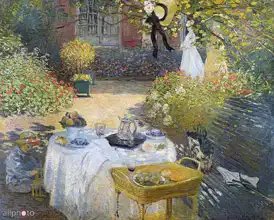About this finishing
Print. The image is printed on the top quality 10-ink HP Z9PS printer on HP matte 270 g / m2 paper. You can choose any size to an accuracy of 1 cm. A margin of 5 cm around the image is added to the size of the motif.


You can find a detailed description about our finishings
here.
Lunch in the garden
Date:
1873Medium:
oil on canvasLocation:
Musee d'Orsay, Paris, FranceDimensions:
160 x 201(Also The Lunch or The Luncheon) Claude Monet exhibited at the Second Impressionist Exhibition in 1876. He painted it for Ernest Hoschedé as a decoration for his Rottenbourg residence in Montgeron. The charm of the painting creates the impression of spontaneity, the simple joy of family life (the table after lunch has not yet been cleaned, a hat hanging on a branch, a parasol placed on a bench. In the shade of a bush, Jean Monet is playing with sticks.
Monet painted picture Lunch in the garden in 1873. Prevailing color of this fine art print is vivid and its shape is landscape. Original size is 160 x 201. This art piece is located in Musee d'Orsay, Paris, France. This image is printed on demand - you can choose material, size and finishing.
Claude Oscar Monet (1840-1926). A native Parisian, who thoroughly developed the idea of
Impressionism. Monet almost scientifically studied the effect of light on different objects. He devoted himself to so called transitory states, which quickly led him to work with colour and light, his paintings acting on the viewer from the first impression. His use of open-air painting and objects which were special only because of light opened the way for the beginnings of modern painting. Monet’s
Impression, Sunrise (1874) not only gave the name to the whole art movement, but secured Monet a place among the best painters of all times. At one time, he resided in London and created his famous study
Houses of Parliament (Monet wondered, How could the English painters paint Parliament when it cannot be seen for the fog?). In the
Giverny, which became his favourite retreat after the death of his wife, he painted motifs from his garden and the popular series
Water Lilies - the world of the water was as poetic and mysterious as a primordial paradise.


